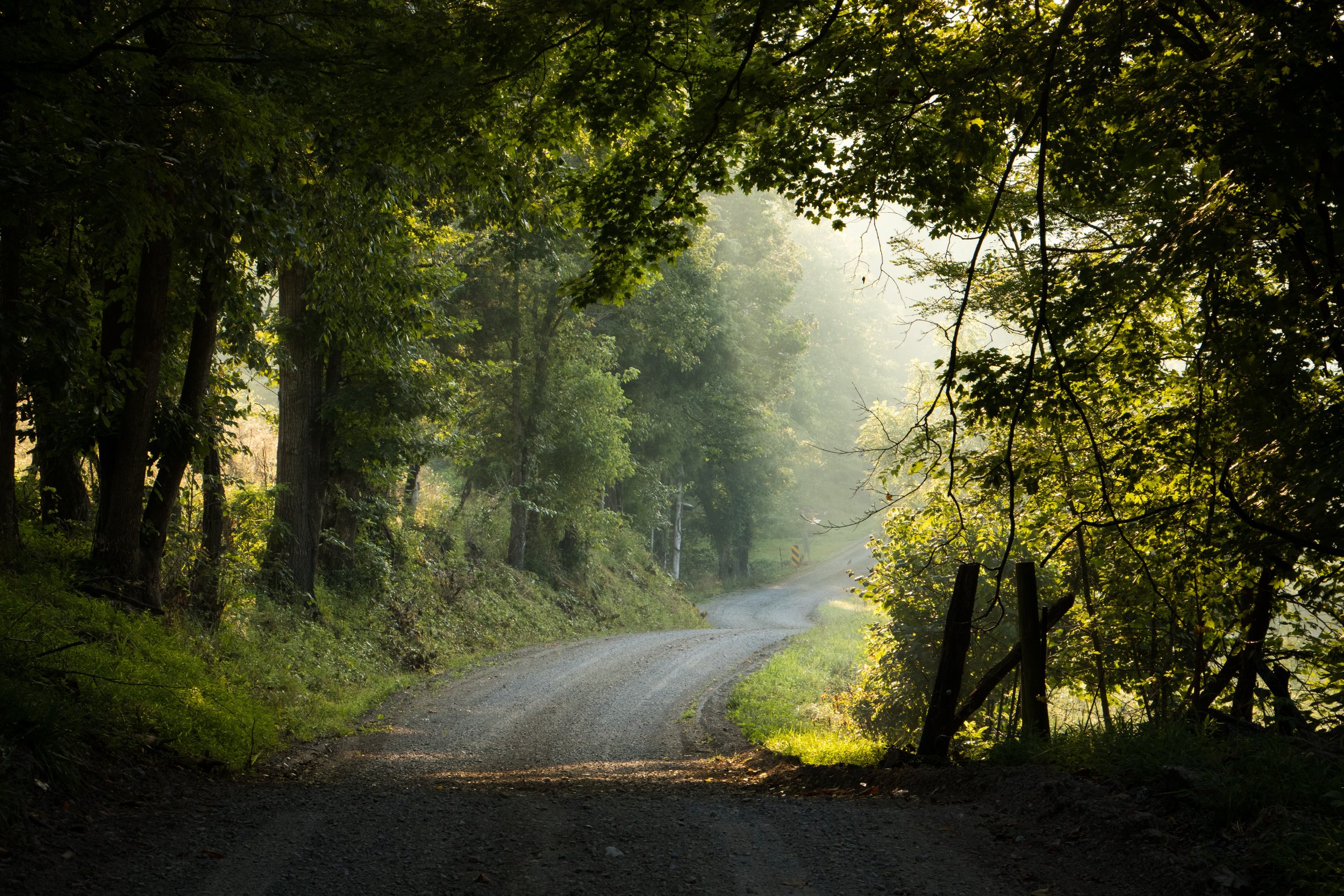Stripes of Inspiration: Drawing Garfield in Muncie

At the end of August 2023, I flew to Indianapolis where my friend, the artist Kate Parnell, picked me up in her mom’s silver Hyundai Sonata of late-90s vintage. It maxed out at 62 mph. Above the license plate, Kate had stuck a bumper sticker that read “Garfield from Memory,” the name of a four-year art project that had become her full-time job. The tagline: “The great thing about painting Garfield from memory is no one can tell you you’re wrong.”
We drove eagerly, if slowly, the 75 miles to Muncie, the home of Garfield’s creator, Jim Davis, and where Kate was to hold an art sale at a tattoo parlor the next day. Weeks earlier, Kate had written Davis a sweet letter. In it, she explained that she “started drawing Garfield when she was very sad” and that “drawing Garfield had been one of the few things that made her happy.” She invited him, if he was free, to meet with her in Muncie. In anticipation of Kate sending this letter, I bought my plane ticket. The letter had been integral to convincing my wife that I should use our frequent flier miles, that this potential rendez-vous between Davis and Kate would be important enough for such expenditure.
I’d been wanting to get back in touch with Kate since early in the Covid-19 pandemic, when I watched her Instagram fill up with Garfield-themed paintings: a Christmas card depicting Garfield-esque wise men cooing over a kitten; a painting of a pipe onto which she’d sketched cat whiskers and the caption Ceci n’est pas une Garf; and a version of Nirvana’s Nevermind album cover on which she’d added a striped tail and cat penis to the dollar-chasing infant.
Of all our high school friends, she was the only one devoting her life to art. I’d written two books of poetry, but after becoming a parent, moving to Texas, and enduring the pandemic, I felt increasingly disconnected, both to my writing and to other people. My favorite thing about writing has always been those moments when a whole creative world opens up, words arrive in unexpected combinations, and any amount of time can pass without me realizing. This is where anxiety unwraps into excitement and ambivalence smooths into abundance. It’s where love and doubt become tools of beauty and not the ingredients of unhappiness. In this world, I am one self and not a cock-eyed collection. Like many writers, this space is my proxy for the divine.
But, more and more, I couldn’t find that generative space. I wondered if I was too sad to go there, or if it would make me too sad if I did, or if that space didn’t exist at all for me anymore. I wondered if sadness was even the correct name for the near-nightly experience of finding myself browned-out on the couch, wondering what—if anything—had gone wrong. Was it parenting young children, the pandemic, becoming middle-aged? Was it experiencing all three in North Texas, 1,000 miles from anyone I’d known before?
I had moved to Texas and become a university lecturer in part so I could continue to write. But several years later, I felt lonelier and less like a writer than ever. My physical dislocation seemed to mirror my dislocation from making art. But here was Kate’s Garfield from Memory project as a counterexample to my disillusionment. Unlike me, her entry into middle age included the discovery of an everyday practice that was silly, uplifting, and sustaining—she even made enough money from her sales that she’d quit her longtime job at an art supply store and now travelled the country selling her work.
“She’d glimpse herself in the mirror and be surprised by her orangeness. Taking over the basement of her childhood house had caused her often to feel like a surly cat, repurposing a suburban house to her own ends.”
I knew that wasn’t easy. On the phone, she told me about her divorce and subsequent depression, and her recent move back to her parents’ house—a move designed to cut costs and help care for her father who’d been diagnosed with Alzheimer’s. I wanted to hear how living in her childhood basement squared with the opportunity to make art day and night, and most of all what it looked like for a middle-class kid from Richmond, Virginia to become a full-time artist in her forties. The occasion of Kate announcing her project’s existence to Davis was almost more of a homecoming than if we’d met up in our old neighborhood. It felt like an announcement of a more exuberant adulthood than the prudent one in which I felt stuck.
*
Coming into Muncie, Kate revealed she’d never sent Davis her letter. Instead, she posted it on Instagram and tagged Paws, the company Davis created to house his Garfield-related franchise.
“I was afraid it would annoy him,” she admitted.
“Goddammit,” I said.
Kate explained that sending the letter had started to feel too much like asking for parental approval, and we both were dubious about the value of Davis blessing Kate’s art. If he liked it, that would be cool—but then what? If he didn’t, that would be upsetting, but not so upsetting as to convince Kate to stop drawing Garfield from her own memory.
As we walked into 111 Arts Gallery, the tattoo parlor hosting Kate’s art sale, we discussed how tattoo enthusiasts in particular seemed to grasp Kate’s premise—that injecting Garfield into unlikely situations is a way of rendering lived experience hilarious and meaningful. Kate’s paintings, like tattoos, offer a sense of agency in a world flooded with images. They invite viewers to imagine and to create their own combinations. The possibilities are never-ending. According to Nate, the owner, “Tattoos are all about pushing things past their original use, and so are tattoo people.”
Kate had, at the time, 38 Garfield tattoos. She had Garfield claws scratching the backs of her legs, images from Garfield comic strips covering her arms. The total effect had become more apparent to her now that she’d moved back home. She’d glimpse herself in the mirror and be surprised by her orangeness. Taking over the basement of her childhood house had caused her often to feel like a surly cat, repurposing a suburban house to her own ends.
“It surprises me how much I’ve committed to the bit,” she said. Her Garfield from Memory project confirmed for her that to do the art full-time was also to become the art. This concept troubled me. In my late twenties, I found the anxiety and loneliness I channeled into my poems almost unbearable in everyday life. By the time therapy began to help, I’d finished a manuscript and couldn’t imagine continuing to write poems from a place of such agitated soul-searching. So I didn’t. Soon after, I got married, had kids, and became more professional as a teacher and less ambitious as a writer. A decade later, I felt I’d overcorrected by drawing the boundaries between creative uncertainty and adult stability too boldly. The fact that I have no tattoos seemed to symbolize this as I stood in 111 Arts Gallery. I briefly wished to be covered in them. It was disconcerting to think that my desire for balancing a family, a career, and my writing, instead of leading to broad fulfillment, had pulled me in too many directions, and made me increasingly isolated as I attempted to move in all of them at once. Teaching online through the pandemic showed me that it wasn’t worth it to move so far away. I had work friends but lacked community. If I could have figured a way to quit my job and not send my family into bankruptcy, I would have done it. But turning 40 made me fear I was too old to start over.
In the last decade, Kate had also experienced a drastic disconnect from her art, and a tumultuous reunion. Although she’d had some gallery shows after completing an MFA in painting, she began increasingly to feel she’d swallowed a crit group and couldn’t cough it up. For years, she hadn’t considered herself an artist at all. That is, until an afternoon in 2019 when she began idly sketching a Garfield-themed umbrella holder that sat by the door of a café.
Soon, she was drawing Garfield in notebooks on bus rides home from the art supply store. Her doodling connected her to the feeling of drawing in grade school. One day, after she’d transitioned her personal Instagram into a business account and paid several months’ rent with her art sales, she thought it would be funny to repaint a wooden placard that displayed the popular religious poem “Footprints” beside an image of Jesus on the beach. The poem’s ending reads: “The Lord replied, ‘The times when you have seen only one set of footprints, my child, is when I carried you.’” This was exactly the kind of kitschy decoration she loved most to Garf up. To Jesus she added an orange face, cat ears, whiskers, and a tail. When she finished, she saw that the new image showed something absurd and true: Garfield had carried her. Hours later, the painting sold on Instagram for $100.
We both took this story as confirmation from the universe that she was doing what she was meant to do. It hadn’t started with a grand vision. It started when she drew a familiar character in a way that made her laugh. Any gravity the paintings acquired was a happy accident.
What I liked most about this story is that it suggested a way out of the all-or-nothing thinking I’d been stuck in. I didn’t need to cover myself in tattoos, and I didn’t want to blow up my life. Hanging out with Kate was a step toward opening myself to small and unexpected joy.
*
When the art sale at 111 Arts Gallery began, Kate’s booth contained a wooden Garfield heart, coasters resembling Garfield pizza slices, several oversized Garlboro cigarette boxes, and a figurine that was a mashup of Garfield and Offred from The Handmaid’s Tale. On another table, she set out instructions for drawing Garfield—“start with the eyes”—and a notebook to collect people’s sketches. In front, she displayed a painting of a well-loved Garfield stuffed animal from a viral meme that showed the same threadbare stuffy and the caption “To love something is to be changed by it.”
An early patron bought a wood painting in the shape of Garfield cowboy boots, a drawing of the sitcom alien Alf eating a Garfield hoagie, and several other sketches. “I’m always trying to decorate my kitchen in the style of orange, gay, crazy,” the woman said as Kate received her Venmo.
Kate gave her—gave everyone—almost half off the sticker price of her purchases, collecting $70 instead of $140. After the woman left, she admitted that she always struggled to ask for enough, attempting to make a person’s day instead of making more money. “Sometimes I wonder: Would it really feel better to sell a piece for thousands of dollars to a millionaire?” she said after the woman left.
Downtown Muncie was hosting an art walk, so the booth remained busy into the evening despite the fact that we were the wild ones around the corner from Middletown respectability, not part of the official art walk, but adjacent to it. I felt happy that Kate was living the adulthood we’d imagined in high school—sitting outside, making money from her own creations, having long conversations with strangers. I admired her for constructing her life around creativity and openness.
A woman who bought a painting of the Challenger explosion with Garfield’s likeness apparent in the smoke clouds compared the piece to Roy Lichtenstein. Other people wondered if Kate got any static from Davis or his lawyers. A story persisted, probably a myth, that there was a bunker in the Paws office complex filled with confiscated, unlicensed merchandise. This anecdote competed with Kate’s own fantasy of Davis silently blessing all the knockoffs, of which there were many: Garfield Minus Garfield, most notably. She probably didn’t have to worry. More than Garfield as a whole, her work focused on Garfield’s attributes: eyes, whiskers, stripes, tail. That year, I’d seen a museum exhibition about Monet’s garden paintings. We laughed to think that Garfield’s stripes had become Kate’s water lilies.
*
The sunset added a brief intensity to the orange art on Kate’s tables. We started to pack up once it got dark. All day, we’d wondered if Davis might actually appear. Now that we knew he wouldn’t, we sat on a bench talking about Kate’s dad. His Alzheimer’s diagnosis put the “from memory” aspect of her project into new light. She’d been focused overtly on the Garfield part, but the “from memory” part now seemed at least as important.
She thought about pictures she’d seen of what Alzheimer's does to the brain. If she squinted at her Instagram feed, it seemed that over and over she’d drawn cat ears and eyes onto the plaques and tangles evident in the brain scans of Alzheimer’s patients. It was as if she was doodling against a terrible inevitable, as if she had found a way to paint big-hearted irreverence into the space where synapses begin to fail. She started to feel she was creating a spiritual photo album about the love and humor that sustained her family.
“I had imagined pursuing art as a dire thing to attempt, something that might depress me and ruin the careful balance that allows me to be successful as a parent and a teacher. ”
The move home had been difficult. Her parents needed more help than she’d imagined and still managed to treat her like a teenager at times. Beyond the aggravation of this, however, there was also a sweetness. When she had enough space, she could appreciate that her parents treated her like a teen because they cared about her. She also came to appreciate that painting Garfield had started as a way to care for herself and led her to this opportunity to care for her parents. Whereas earlier in her life, making art had defined her against her parents, in this new chapter, caring for them and painting Garfield were part of the same endeavor.
*
Now, when I scroll Kate’s Instagram I start to see something uplifting and deeply funny. I think about how Garfield from Memory started while she endured one of the loneliest points of her life and led her to make new connections between people. I felt lucky these connections included me. Our trip showed me that painting isn’t just a substitute for human connection, but an antidote to loneliness. Painting Garfield was like a wormhole Kate leapt through with the basic faith that what energizes her will energize other people. I would have imagined something serious and profound as the epicenter of that energy, which makes it more hilarious that for Kate, the energy emanates from Garfield. That humor, finally, is what allowed me to admit that I’d lost a necessary tolerance for sitting with myself and seeing what creative possibilities might bubble up. I had imagined pursuing art as a dire thing to attempt, something that might depress me and ruin the careful balance that allows me to be successful as a parent and a teacher. Now, when I look out at a romantic and desolate Texan vista, I sometimes imagine a faint Garfield face looking back at me. When I do that, I’m more able to lose myself in a world of creative connection that, since this trip, has reinvigorated my writing and led me to other artists. My loneliness becomes iterative. I now know that goofiness is sometimes the quickest path to inspiration.
ABOUT THE AUTHOR
Jack Christian is a poet and essayist interested in collisions between art, landscape, and money. He is the author of the poetry collections FAMILY SYSTEM (2012 Colorado Prize, Center for Literary Publishing) and DOMESTIC YOGA (2016, Groundhog Poetry Press). His recent work has appeared in ArtForum, Bennington Review, Cleveland Review of Books, The Diagram, and New York Times Magazine. Lately, he's been writing reviews of his adventures as a Minneapolis transplant on his newsletter Day Dates.
Read Jack’s “Behind the Essay” interview in our newsletter.
Edited by Tusshara Nalakumar Srilatha.
Header photo by Andres Labarrios Linares.
Photos by Jack Christian and Kate Parnell.
















At the end of August 2023, I flew to Indianapolis where my friend, the artist Kate Parnell, picked me up in her mom’s silver Hyundai Sonata of late-90s vintage. It maxed out at 62 mph. Above the license plate, Kate had stuck a bumper sticker that read “Garfield from Memory,” the name of a four-year art project that had become her full-time job. The tagline: “The great thing about painting Garfield from memory is no one can tell you you’re wrong.”